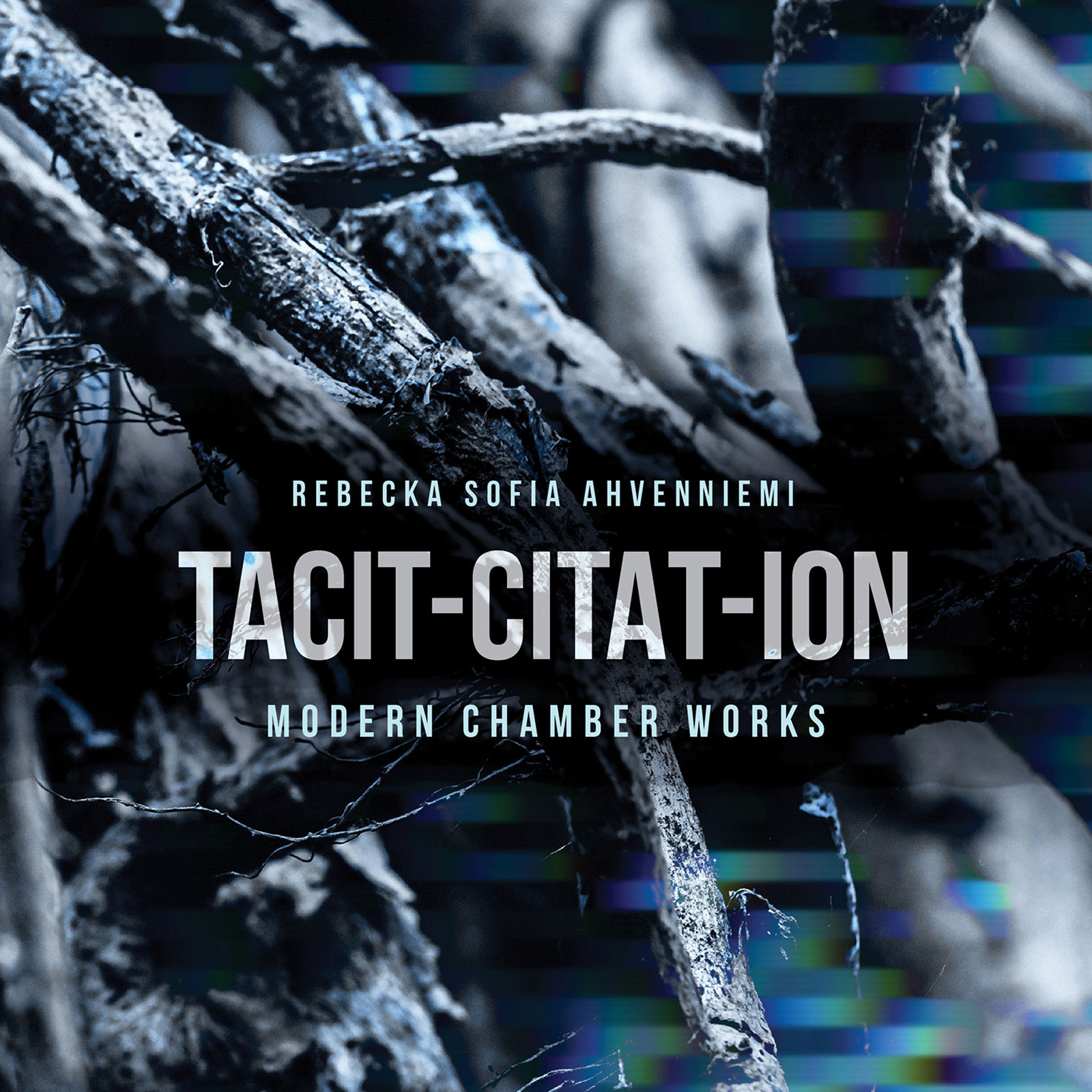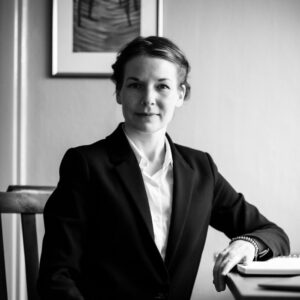
Share Album:
Tacit-Citat-Ion
Rebecka Sofia Ahvenniemi composer
Rebecka Sofia Ahvenniemi’s debut TACIT-CITAT-ION is a reflection of contemporary Scandinavian composition – gestural, yet empowered by painstaking attention to detail. Where other composers’ work ends, Ahvenniemi only begins. Breath sounds, glottal stops, microphone static, white noise, electronic interferences, the percussive friction of instrument bows – these byproducts of music are the backbone of TACIT-CITAT-ION, yielding a truly unique auditory experience.
Internationally educated and performed, Ahvenniemi exemplifies the new generation of musical tradition in the Nordic countries. Elements from previous musical epochs are eclectically drawn upon, such as romantic operatic singing in Dada-aria or the mix of classical and jazz elements in L’operette d’amour. Each of the works individually engages in reflecting the traditions of music and the surrounding society. The echoes of traditions are brought into the context of contemporary music through specific choices concerning scores, treatment of sound, and sound technology.
Perhaps most importantly, there is a unique philosophy behind this music which is unfussy yet avantgarde – no minor feat by any means. Nowhere is this more apparent than in the album’s eponymous track Tacit-Citat-ion, a post-modern composition for string quartet stylistically reminiscing about the ethereal qualities of composers such as Kaija Saariaho, Salvatore Sciarrino, Giacinto Scelsi, and Hans Abrahamsen. The title refers to the idea that no work appears outside of a historical context of musical codes.
It is no wonder, then, that the Norwegian Composer’s Society willingly supported the creation of this album: with its prominent intellectual quality and uncompromising melange of stylistic elements, Ahvenniemi’s compositions encompass the late-breaking zeitgeist of Nordic and contemporary European composition like few others.
Listen
Stream/Buy
Choose your platform
Track Listing & Credits
| # | Title | Composer | Performer | |
|---|---|---|---|---|
| 01 | Dada-Aria | Rebecka Sofia Ahvenniemi | Melis Jaatinen, mezzo-soprano | 4:33 |
| 02 | Wuthering Modes (Not Moods) | Rebecka Sofia Ahvenniemi | BIT20 Ensemble | Jutta Morgenstern, 1st violin; Martin Shultz, 2nd violin; Liene Klava, viola; Agnese Rugevica, cello | 5:39 |
| 03 | Winds | Rebecka Sofia Ahvenniemi | Rebecka Sofia Ahvenniemi | 4:09 |
| 04 | Herz beim Spinnrade | Rebecka Sofia Ahvenniemi | Silje Aker Johnsen, soprano; Ellen Ugelvik, prepared piano | 5:25 |
| 05 | L’operette d’amour | Rebecka Sofia Ahvenniemi | Hilde Annine Hasselberg, soprano; Manuel Hofstätter, percussion | 0:38 |
| 06 | Ode to a Tree | Rebecka Sofia Ahvenniemi | Joshua Rubin, Bb clarinet | 4:59 |
| 07 | Lucia | Rebecka Sofia Ahvenniemi | Yumi Murakami, piccolo | 4:44 |
| 08 | En ryslig berättelse | Rebecka Sofia Ahvenniemi | Hilde Annine Hasselberg, voice; Manuel Hofstätter, percussion | 9:36 |
| 09 | Banalala | Rebecka Sofia Ahvenniemi | Hilde Annine Hasselberg, voice; Rebecka Sofia Ahvenniemi | 7:23 |
| 10 | A Song for the Viola | Rebecka Sofia Ahvenniemi | Hans Gunnar Hagen, viola | 3:07 |
| 11 | Tacit-Citat-ion (Version for String Quartet) | Rebecka Sofia Ahvenniemi | BIT20 Ensemble | Jutta Morgenstern 1st, violin; Martin Shultz, 2nd violin; Liene Klava, viola; Agnese Rugevica, cello | 7:36 |
Track 1 text from Rebecka Sofia Ahvenniemi
Track 1, 7 recorded May 10, 2018 at Nesodden kirke in Nesoddtangen, Norway
Engineer Manuel Madsen
Track 2, 11 recorded October 29, 2018 in Troldsalen, Troldhaugen in Bergen, Norway
Engineer Gunnar Herleif Nilsen
Track 3 recorded, performed, and fixed November 2016 by Rebecka Sofia Ahvenniemi
Electronic work, fixed media sound; Originally for 8-channel surround-sound, using Ambisonics
Track 4 recorded August 30, 2018 at Morten Qvenild Studio in Nesoddtangen, Norway
Text quotes from Johann Wolfgang von Goethe
Engineer Manuel Madsen
Track 5
Electronics as a loop
Track 5, 8, 10 recorded August 31, 2018 at Duper Studio in Bergen, Norway
Engineer Yngve Leidulv Sætre
Track 6 recorded November 7, 2017 at Oktaven Audio in Mount Vernon NY
Live recording with fixed media
Engineer Ryan Streber
Track 7
Electronics as amplification and delay
Track 8 text quotes from Tove Jansson “Berättelsen om det osynliga barnet”
Live recording with fixed media
Track 9 recorded, performed, and fixed March — April 2014 by Rebecka Sofia Ahvenniemi
Text quotes from J. G. Ballard
Electronic work, fixed media sound
Track 10
Live recording with fixed media
Artist photography Karjaka Studio 2017
Executive Producer Bob Lord
Executive A&R Sam Renshaw
A&R Brandon MacNeil
Vice President, Audio Production Jeff LeRoy
Mastering Shaun Michaud
Production Engineer Lucas Paquette
Art Director Brett Picknell
Design Ryan Harrison, Edward A. Fleming
Publicity Patrick Niland
Artist Information

Rebecka Sofia Ahvenniemi
To listen to Rebecka Sofia Ahvenniemi’s music is to become open to the possibility of hearing surprising things: in her work, and through her compositional methods, the familiar is made strange and the unfamiliar finds space to sound. One encounters quotations from music history (or are they imagined quotations?), as well as fragmented and invented languages. The listener is invited to explore the intimate and hidden, gestural and timbral qualities of sound. Working with scores, electronics, voices, and instruments, Ahvenniemi creates works that range from operatic and theatrical scenes to solo compositions.
